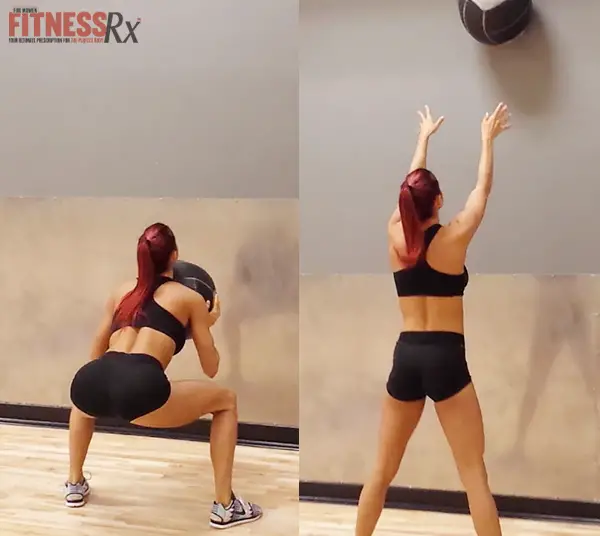Video Demonstration
This article will cover every thing you should know about the Wall Throws exercise.
We will include video, image and a written step by step description on how to do this exercise.
Its difficulty level, the equipment you need to do it. The different muscle groups that get worked when you use this exercise.
The benefits you get when adding it to your training routine. Also, some different training tips to use to help make sure you are performing it correctly.
Wall Throws How to Guide
Image Example

Step by Step Description
Step 1: Stand facing a wall. Have the wall about 3 to 5 feet away from your body. Put your feet slightly closer than shoulder width apart. Keep your back straight, chest pressed out, and your shoulders pulled back while holding your core tight.
Step 2: Grab a medicine ball and place the palms of your hands on its sides towards the bottom of the ball. Hold the ball at chest height.
Step 3: Lower your body by pushing your hips backward while bending at the knees. Keep lowering your body until your knees come in line with the crease of your hip.
Step 4: Once you have reached the bottom position of the squat immediately reverse direction by driving through your heels. Create as much momentum as you possibly can and use it to help drive the medicine ball up throwing it at the target you picked on the wall.
Step 5: As the ball bounces off the wall get your hands ready to catch it. The second the ball touches your hands immediately begin descending into the next squat and repeat.
Congratulations you have now completed one repetition of the Wall Ball Exercise.
Difficulty Level
The Wall Ball Exercise gets rated at an intermediate difficulty level.
You should have spent some time practicing the bodyweight squat before you add this lift into your training routine.
Equipment Required
To perform this exercise, you will need a medicine ball.
As you continue to progress on this lift, you should increase the weight of the medicine ball to make sure you keep improving with this lift. You can also use weighted clothing to make this exercise more challenging.
Muscles Worked
The different muscles that get worked when you perform this exercise are your Quadriceps, Glutes, Hamstrings, Calves, Shoulders, Core, and the Triceps.
Benefits From Doing Wall Throws
Wall Ball Throws are a functional movement. Squatting and lifting objects overhead is a regular activity performed in many peoples daily routines. Strengthening these muscles in the gym will lower your chances of receiving an injury when you are performing daily activities.
Being a compound movement that uses multiple muscle groups allows your body to burn many calories in a short duration.
You will be strengthening your body and working on your cardiovascular system at the same time. This makes Wall Throws exercise an extremely beneficial training method.
Training Tips
Pick a spot on the wall to aim at for every one of your throws.
Remember to use the momentum you build up with the squat to help you throw the ball.
While the ball is still in the air, lower your arms to your sides to give them a brief rest.
Do not let your knees go past the tip of your toes. When this happens, additional stress gets placed on your knee ligaments increasing your chances of injury.
Alternate Exercises
- Goblet Split Squat
- Squat Hops
- Trx Jump Squat
- Squat Jacks
- Bulgarian Split Squat Jumps
In closing
If you are planning to use this exercise in an H.I.I.T program, check out our free online H.I.I.T Timer. It is free to use, and no registration is required.
Remember to focus on your form. The moment that your form begins to break down stop and take a quick rest before completing more repetitions.
If you have never done this exercise before you should add it to your routine for at least a few months to see for yourself all the benefits it has to offer.
Looking to gain more strength or lose some weight? We offer free fitness tools to help you reach your fitness goals. Register for free while we are in beta and get free lifetime access to our fitness tools that include an easy to use Calorie Counter, High-Intensity Interval Timer, Multiple Fitness Calculators and our Exercise Logger.